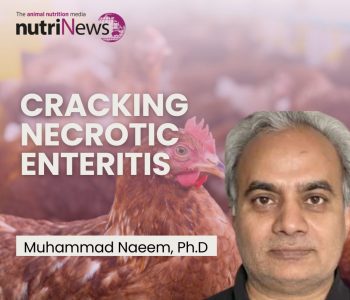In this episode of NutriNews on Air, we sit down with Dr. Muhammad Naeem, Post-doctoral Fellow at Auburn University, to explore one of the most pressing challenges facing broiler producers today—necrotic enteritis (NE). As the poultry industry continues to transition away from antibiotic growth promoters, understanding and mitigating the risk of enteric diseases like NE is more critical than ever.
Drawing on his academic research and field experience, Dr. Naeem outlines practical, science-based strategies for controlling NE through nutrition, feed hygiene, and management.
🚨 What is necrotic enteritis, and why is it a persistent problem?
Necrotic enteritis is an enteric disease of broilers caused primarily by toxigenic strains of Clostridium perfringens. It often occurs in the small intestine and is associated with severe mucosal damage, which results in poor nutrient absorption, reduced weight gain, and—in acute cases—high mortality.
Dr. Naeem emphasizes that NE can manifest in two major forms:
-
Clinical (acute) NE, characterized by sudden onset, diarrhea, depression, and mortality rates between 1–10%.
-
Subclinical NE, often more insidious, leads to chronic intestinal inflammation, decreased feed efficiency, and economic losses without obvious symptoms.
Several factors contribute to NE outbreaks:
-
Coccidiosis (especially Eimeria maxima) is a major predisposing factor that disrupts gut integrity.
-
Diets high in animal protein or non-starch polysaccharides can promote C. perfringens proliferation.
-
Withdrawal of in-feed antibiotics has made NE control more complex, particularly in ABF (antibiotic-free) systems.
🧪 Nutritional strategies: Building a feed formula that protects the gut
According to Dr. Naeem, preventing NE requires a comprehensive nutritional approach that targets the root causes of intestinal imbalance:
✅ Protein management
Reducing the overall crude protein (CP) content in the diet is critical. Undigested protein reaching the hindgut can serve as a substrate for pathogenic bacteria.
“The goal is not just to lower CP but to maintain ideal amino acid ratios,” explains Dr. Naeem. “That’s where synthetic amino acids and exogenous proteases become valuable tools.”
✅ Enzymes that support digestion
Feed enzymes such as xylanases, amylases, and proteases enhance nutrient digestibility and reduce intestinal viscosity—especially in wheat- and barley-based diets. They also minimize the growth of opportunistic pathogens by reducing nutrient availability in the lower gut.
✅ Gut modulators: Probiotics and prebiotics
Probiotics (e.g., Bacillus subtilis, Lactobacillus spp.) can competitively exclude C. perfringens, while prebiotics (e.g., MOS, FOS) nourish beneficial microbes and improve gut barrier function.
“There is strong evidence that multi-strain probiotics, when combined with enzymes or phytogenics, offer synergistic effects,” says Dr. Naeem.
✅ Organic acids and butyrates
Short-chain fatty acids like butyric acid improve epithelial integrity, reduce inflammation, and have direct antimicrobial effects against gram-positive pathogens.
✅ Phytogenics: Nature’s antimicrobials
Phytogenic feed additives—including essential oils such as oregano, thymol, and carvacrol—have antibacterial and anti-inflammatory properties. They support the immune system and can improve feed palatability.
🧼 Feed hygiene: An often overlooked link in the chain
Beyond formulation, Dr. Naeem highlights the importance of maintaining strict hygiene throughout the feed production and delivery system.
-
Ensure clean, high-quality raw materials with low microbial loads.
-
Regularly test feed for mycotoxins, which can compromise gut health and increase NE susceptibility.
-
Use organic acid blends to control microbial growth in feed and drinking water.
-
Keep feed storage areas clean, dry, and protected from rodent or insect contamination.
“Even the best feed formula can fail if hygiene isn’t maintained,” notes Dr. Naeem. “Contaminated feed is a direct route for C. perfringens to enter the gut.”
🧠 Moving toward antibiotic-free: The need for an integrated strategy
As consumer demand and regulatory pressure drive the shift away from antibiotics, Dr. Naeem stresses the need for a holistic, multi-pronged approach.
He recommends the following steps for producers transitioning to ABF systems:
-
Conduct a thorough gut health audit of your flocks and identify stress points.
-
Adjust diets to reduce CP without compromising performance; supplement with functional amino acids.
-
Introduce layered gut health strategies using enzymes, probiotics, phytogenics, and acidifiers.
-
Focus on biosecurity, water quality, and litter management to reduce pathogen pressure.
-
Provide ongoing training for farm staff to monitor flock behavior and early disease signs.
🎙️ Listen to the full interview on AgriNews Play
The full interview with Dr. Muhammad Naeem offers even more practical insights for veterinarians, nutritionists, and farm managers aiming to reduce the risk of NE without antibiotics.
🔗 Tune in soon to listen to the complete interview on AgriNews Play.
Stay ahead of the curve by subscribing to nutriNews, where science meets field practice in animal nutrition and health.
